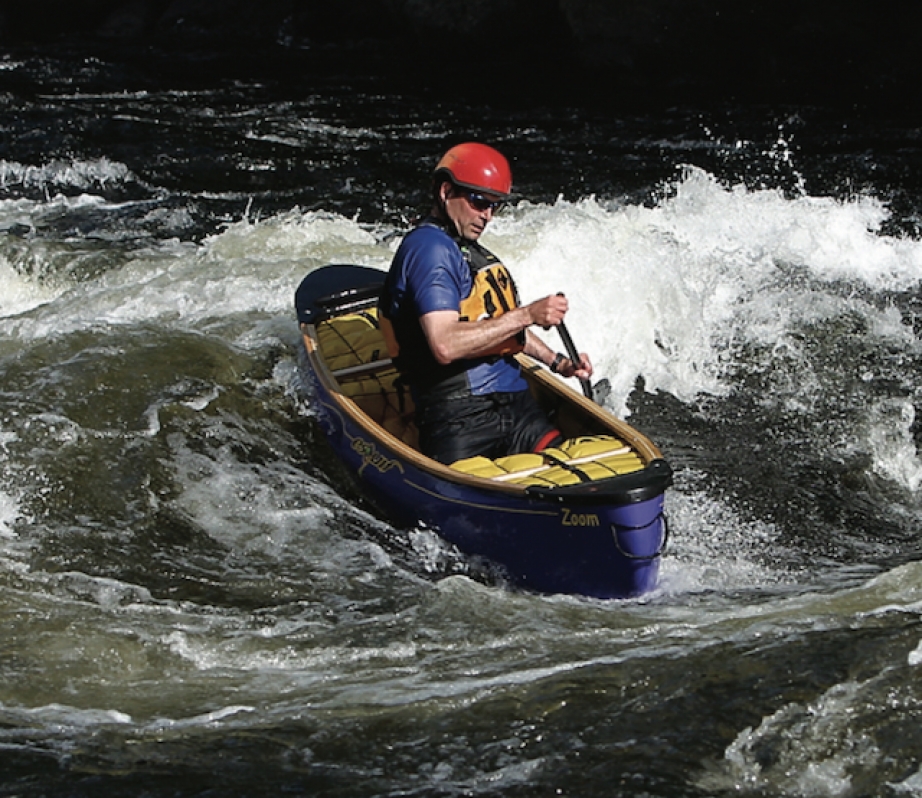Front surfing your canoe on a large wave feels as close to flying as you’re going to get with a paddle in your hands. Controlling your surf on small waves may seem as simple as ferrying your boat. However, on large waves you need a full bag of tricks to maintain your surf for extended periods of time. To really fly on a wave you must carefully control your boat speed, your position between crest and trough, and be able to delicately turn left and right without blowing off the wave. Sometimes, even getting on the wave can be a huge challenge! Consider the following essentials for surfing bigger waves.
THE BOAT
Having the right canoe for the task will be a significant asset. Lengthy boats tend to dive low into the wave trough becoming difficult to control. Once the bows of these canoes plow into the wave upstream of your surf wave it is often ‘game over’. Shorter canoes are much easier to control and fit better on almost any surf wave.
Flatter hulls respond better to rudder strokes used for steering on surf waves. Smaller boats are also much easier to trim front to back on steep waves which helps you control your speed.
THE WAVE
The best surf waves are ones that have a wave face that is equal to, or longer than the length of your canoe. This provides the surface area nec- essary to support the whole boat. A wider and longer wave face gives you room to manoeuvre on the wave—both side to side and up and down. Shorter waves can be surfed provided that they are not too steep. Side to side ‘shredding’ will help prevent the bow from getting stuck in the water upstream of the surf wave.
THE TECHNIQUE
Once on the wave, keep your canoe moving. Ferrying back and forth helps you to stay in control of your speed and your positioning between the wave crest and trough. Gentle side-to-side movement keeps your bow clear of the upstream water while allowing you to stay low, near the trough on the wave. Aggressive left to right play surfs you closer to the crest and helps maintain a free and dry bow on steep waves. Keep your tilts to an absolute minimum. Even without boat tilt, once you turn your canoe, the contour of the water beneath your hull will cause a carve on your downstream edge—very cool!
GETTING ON THE WAVE – WITHOUT STRUGGLING
- Approach from the eddy pool adjacent to the surf wave.
- Enter by paddling into the trough that feeds the surf wave.
- Your speed should match the current so you nei- ther climb upstream past the wave, nor drift down- stream away from the wave.
ACCELERATING – TO HELP STAY ON THE WAVE
- When near the wave crest, straighten your boat and point the bow down to the trough.
- Lean forward slightly and use a rudder for directional control.
- Lower your T-grip hand and place your paddle shaft against the gunwhale.
SLOWING DOWN – TO KEEP THE BOW DRY
- If you’re heading low into the trough straighten your canoe.
- Slow the boat by leaning back. This pushes the stern deeper into the wave crest and decreases downward trim of the hull.
- Push your blade forward using the non-power face as if to do a reverse stroke.
SHREDDING – CONTROL SIDE TO SIDE MOVEMENT
- Position your canoe between the crest and trough
- Lift your bow so that it is free to turn.
- Use a rudder and push or pull the T-grip to turn left or right, much like a stern pry or draw
Andrew Westwood – instructor at Madawaska Kanu Centre, Esquif team member, Rapid columnist.
 This article first appeared in the Fall 2004 issue of Rapid Magazine.
This article first appeared in the Fall 2004 issue of Rapid Magazine.




